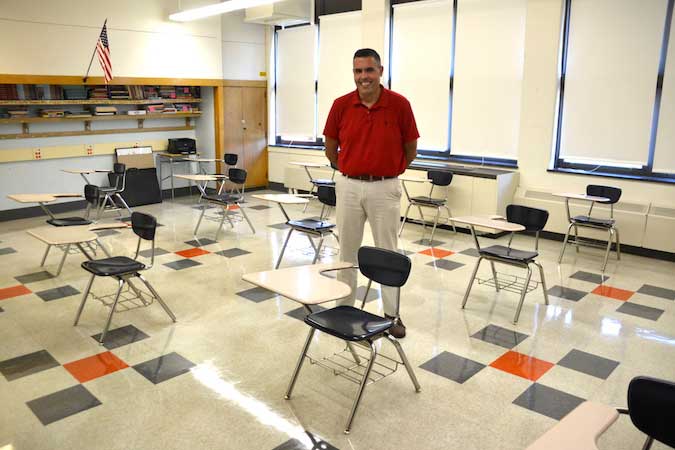Q&A: School superintendent ready to start new year after ‘unreal’ 6 months
Jason Smith and Lyndonville district welcome back students today
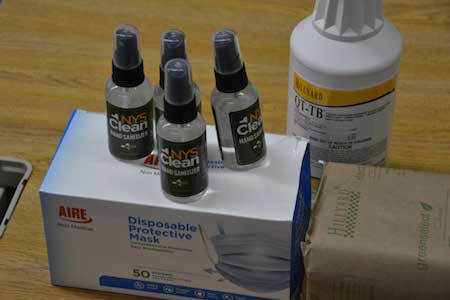
Classrooms are stocked with hand sanitizer, masks and cleaning products.
LYNDONVILLE – Jason Smith has served as Lyndonville’s superintendent of schools since December 2011. The superintendent and district will begin welcoming back students today for a new school year. Lyndonville is staggering the grade levels this week before all grades come back next week for in-person classroom learning each school day.
Lyndonville is able to offer all students the option for in-person learning each day, rather than a hybrid approach like many districts where students come in to school for classes two or three days a week with the other days remotely at home.
Lyndonville, which has 630 students in grades PreK to 12, can accommodate all students with social distancing guidelines in place. The district has three grade levels at the elementary school, which is being used again after closing after the 2011-12 school year.
This year the district will have PreK and grades 5 and 6 in the elementary school.
The district has many new protocols in place to reopen during the Covid-19 pandemic, including taking students’ temperatures, spreading out desks, having students wear masks when social distancing isn’t possible, and making hand sanitizer available.
Jason Smith was interviewed last week in his office at Lyndonville Central School on Housel Avenue.
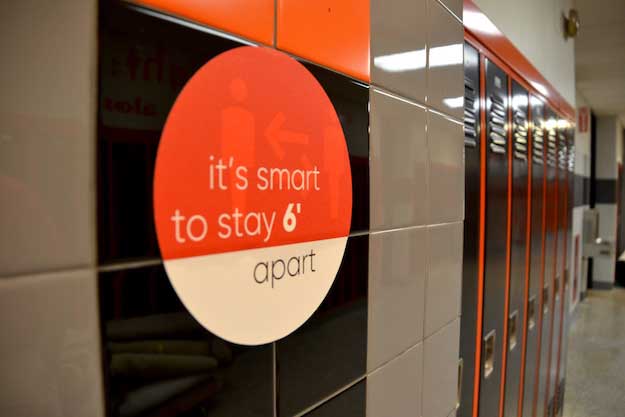
The district has signs and decals throughout the hallways, classrooms and campus, urging people to maintain social distancing and wear masks.
Question: This is your 26th year in education. (Smith started his career in 1994 as a social studies teacher in Albion.) How radically different is this start of the school year?
Answer: It has been a radical start, going back to March. I was telling the families when I did the reopening meetings, I began tongue in cheek by saying I’m a history teacher by trade. We’re learning this as we go.
I’m basically saying I am committed to learning about this and making changes, but understand I was brought up as a history teacher.
March 13 was the last day we had students here. It was unreal because on March 14th I started talking with the superintendents in the county and Paul Pettit (the public health director in Orleans County) and we all closed that day. It was a Saturday.
It was almost like when I was at Albion (as a social studies teacher) and we watched the towers come down in New York City (on Sept. 11, 2001). I watched with eighth-graders in the cafeteria hallway. Standing next to me was Joe Martillotta (another social studies teacher).
March 14th was another surreal moment. It took about four hours from 1 to 5 to get everything done that I needed to get done. Then my wife and I went out to dinner for the last time for a while. Then I went back to work that night and had a call with my administrators. It was very much like I can’t believe this is happening.
It’s been six months. It’s definitely been out of the ordinary. I’ve had many calls with superintendents in Orleans County and also in the Niagara-Orleans BOCES.
There has been a lot of communication, a lot of problem solving and working to meet the new challenges. There has been a lot of pieces to put together.
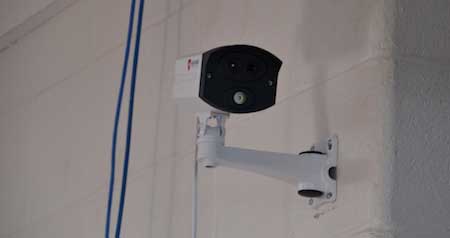
The district has two thermal scanners that doing rapid screens as students enter the hallways in the main building. That scanner will identify students who may have temperatures at 100 degrees or more. Those students will then be checked individually with infrared touchless thermometers. If they have a temp of 100 degrees or more, they will have to go home.
Question: Last year there was such abruptness with the schools closing and the switch to remote learning. This year I know Lyndonville is starting with the option of in-person learning all five days of the school week. At least you know what you’re getting into at the start of the school year.
Answer: We do have about 15 percent or about 80 students who have opted to do remote only, even though we are offering full person instruction. We are offering the remote instruction to our families.
But the other piece is if we get switched to remote by force or by choice, we wanted to make sure we had a better plan in place. As we developed our plan for reopening, we wanted to make sure we had plans for full in-person which we’re doing, hybrid or full remote.
If we have to go full remote, we wanted to make sure we have enough devices and that there are expectations for teachers, students and families for what it looks like.
For example, last year from March, April, May and June, we were on pass-fail. There wasn’t traditional grading because of the challenges we had. But this year, anyone who is on remote, whether they chose it or were on it by force, it’s going to be regular grading and feedback with tests.
We’ve upped our game and everybody needs to up their game and understand it’s going to be graded, whether you are here or not. That is one of the lessons we learned.
We learned to do mobile hotspots. We actually started planning on March 12th in anticipation of what could happen. We had started that inner game plan a couple days before not knowing it would go on for the rest of the year.
Question: Do you have a sense of the percentage of kids that need the mobile hotspots?
Answer: We purchased 40 of them. The ones that we purchased work very well with a Verizon signal.
When Aaron Slack (high school principal) and I drove around the whole district during the graduation parade, oftentimes our phones died because there wasn’t a Verizon signal out on this road or that road.
So there is a strong need (for mobile hotspots). Our school board is committed to having better high-speed internet. We want to engage in the political process to open up broadband.
We opened up the campus here in the library and later on we placed two hotspots at the White Birch and the Oak Orchard Assembly of God.
So obviously the need is strong. It is definitely a handicap for us.
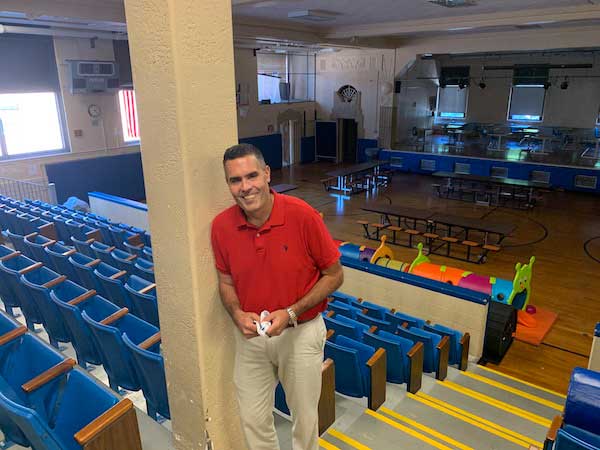
Jason Smith is shown in the cafeteria at the elementary school, where there will be clear dividers in place at the lunch tables. The school building gave the district the option to shift two grade levels, fifth and sixth, from Housel Avenue to free up more space and reduce the number of people in the main school building.
Question: Are the two hotspots still there at the White Birch and the church?
Answer: They won’t be there right to start. We’re going to monitor it and see how it goes. They didn’t get a lot of use last year. It was a cost for us to have them. We will monitor it. People can still use this campus. They can use the Yates library. The students will have access to Chromebooks, too.
Question: People might wonder what has been the hardest part of being a superintendent during the pandemic?
Answer: Just the changing rules. The changing regulations. The communication from the state and making sure I get that communication out to the staff and the parents.
I think one of the new normals for us is we’ve all had to up our communication game. I’ve used all of our systems. I’ve become much more proficient with it. I’ve got the calls out, the texts out, links, all kinds of stuff and getting the website updated.
Those have been some of the challenges, getting as much information out as much as we can.
Question: You function as the chief communication person?
Answer: I do a lot of it or I have someone else do it but I have my hands on the button all the time. We have our website set up with all the alerts on there. I have a great staff, too, and we have BOCES service that helps us out. But if it’s an immediate need I’ll get it up there.
Certainly we miss our students. While we weren’t open since March, I saw one of our students at the EZ Shop. We just kind of smiled at each other and had a prolonged hello because we just missed seeing each other. You miss the hustle the bustle of students and staff in school. So that’s been hard.
And just the unknown and not knowing, and all the planning.
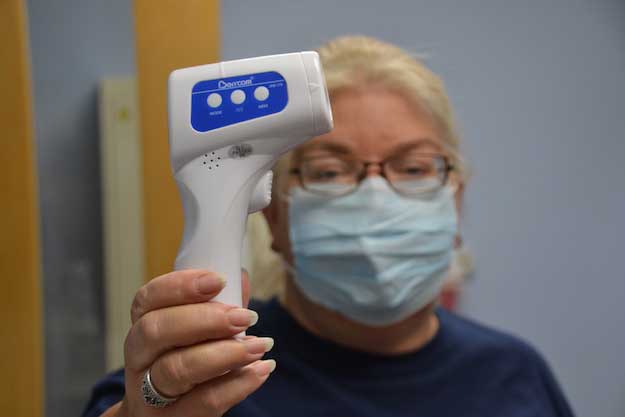
Mary Kurz, the school nurse, holds one of the infrared touchless thermometers.
Question: The fall sports starting on Sept. 21 is confusing with some sports able to go and others not.
Answer: The practices can start on the 21st. The frustrating part for all of us has been we’ve been able to have youth sports with contact but now there seems to be conflicting guidance. Our infection rate in our state is lower than other states, yet those states with higher (infection) rates are able to play football. Why can’t we do that or something similar here?
That’s been a frustrating part.
But we are excited to get the athletics back and again do that in a smart manner. The guidance says maybe two spectators per child and we’ll have to decide how we’ll manage that and keep the density down.
Question: Two spectators per kid that will be a hard deal.
Answer: That will be tough. Some of what is being tossed around is do we give each child two passes? We’re also going to try to livestream some of the events. If people can’t come in person they could watch it on YouTube. We’re going to look at a service for that.

The elementary school last year was used for an expanded PreK program after being closed since 2012. This year it will have PreK, fifth and sixth grades.
Question: If you didn’t have the elementary school option, would you have been forced to do the hybrid without in-person each day for everyone?
Answer: It would have been tight. By having classes there we’ve opened up space here so we can have spillover rooms. So it was definitely to our advantage to have that building. We’re even able to feed students over there.
It definitely made the process easier knowing that we had that space over there.
Question: In terms of a silver lining, I have to think the kids will be really happy to see each other and they will value in-person friendships.
Answer: Yes, we saw how quickly it all ended last March.
Another challenge we had going back to June was graduation. It was one big task at a time. In March and April it was getting the meals out and the technology out.
In May and June we started having talks about graduation, which is a huge event.
We kind of took a breath and waited for guidance from the state about reopening the schools. We formed a committee, and had that going on the last two weeks in July. Ultimately I did nine presentations, one to the board, six to parents and two to teachers.
It’s easy to be overwhelmed, trying to keep up with the federal laws and the state laws. You want to balance parent needs, student needs and staff needs.
Question: I’m guessing you haven’t had much of a break personally since March?
Answer: Me, no. I had a vacation I was going to take over Memorial Day weekend but it was cancelled.
I will say this, I try to give myself so downtime because the job can be so demanding. During the shutdown I was looking at emails 24-7 trying to keep up with what parents and staff needed, what students needed. I was in constant contact with the administrators. It wasn’t until July when I took every other Friday off. That’s what I was able to do. The idea of taking a week off, for one, where are you going to go? Every place I wanted to go was quarantined.
So you try to balance it out and keep your Sundays free. The job is challenging enough and you add (Covid) to it, it’s another 25 layers.
Question: What else would you like to say?
Answer: It’s been a good process, we’ve learned and we’ve grown as administrators, as staff, as teachers. We’ve all learned.
There are some things we will keep on doing when this (Covid) is done. For example I used to have to drive to Sanborn once a month for a meeting (with the Niagara-Orleans superintendents). Do I have to do that anymore when we can do the same thing online? It saves money. It saves time. It saves gas to do things here. Why do I have to drive there when every Tuesday I’ve been doing Zoom meetings with the superintendents, although there is value to meeting in person, but maybe we’ll do it once every three months in person.




























